Introducing a Cat and a Dog
By Sherry Woodard, Best Friends animal behavior consultant
Some dogs do fine living with cats; others simply cannot live safely with felines. Even if the dog has cat experience and the cat has lived with a dog before, proceed cautiously during the first introduction. It’s best to have two people present, one to intervene with each animal if necessary. If you have more than one dog, introduce each dog separately to the cat.
The dog should be held on a loose lead. One person should watch the dog’s body language and the other should watch the cat’s. If the cat is not acting aggressively (raising his back, hissing) toward the dog, he can be allowed to move around freely. A cat is rarely a threat to a dog, but there are some cats who will meet dogs aggressively. If the dog is not acting aggressively toward the cat, then you can ask the dog to sit, or lie down and stay, while the cat moves around freely, sniffing the dog if he wishes. The dog should be praised and rewarded if she ignores the cat.
If the dog has a strong prey instinct, she will become very focused; she’ll stiffen and stare, and may start barking or whining. If you see these signs, do not allow the dog near the cat. Especially, do not allow the dog to chase the cat. If the dog lunges and tries to chase the cat, you should try a different strategy for getting them to share space.
Instead, put the cat in a bedroom with a tall baby gate across the door. Give the kitty all needed supplies: litter box, food and water. Allow the dog to view the cat briefly through the gate, and then get the dog to focus on something else, like playing or practicing cues. Praise and reward the dog for being able to focus elsewhere. Continue to give the dog short viewings of the cat throughout the day.
The hope here is that the dog will eventually lose interest in the kitty. In some cases, the dog will lose interest in the cat within a couple of hours, but some need days, and others simply will not be able to share a space safely with a cat. If you don’t feel you can trust your dog around your cat, you should keep them apart. Many dogs can injure or kill a cat very quickly, and dogs can also be injured by cats (eye injuries are not uncommon).
Now, about kittens and puppies: If you are introducing a kitten to more than one dog, again, introduce only one dog at a time. Small kittens may not have any fear of dogs, so you must watch the dog carefully. If your dog is young and high energy, he could hurt or kill the kitten simply by trying to play. Because kittens are small and want to run and play, dogs with a strong prey drive may be very excited by a kitten’s movements.
In fact, kittens and dogs should not be left alone at all. Even if your dog is okay with your adult cats, she may become too rough with a kitten and hurt him. So, for safety’s sake, keep small kittens and dogs apart any time you are not watching them.
Introducing puppies and adult cats can sometimes be easy, since a well-socialized adult cat will quickly stand up for himself and “tell” a puppy to respect his personal cat space. However, if your rambunctious puppy is chasing your shy cat, the cat may need your help to control the puppy. Until the puppy is old enough to have more self-control and has had some training, baby gates can be used to keep the animals safely and comfortably apart.
Animals with good past experience often adjust well and quickly. But, if introductions do not go well, seek professional help from a behaviorist. Don’t ever use punishment: It will not help and it could make matters much worse.

